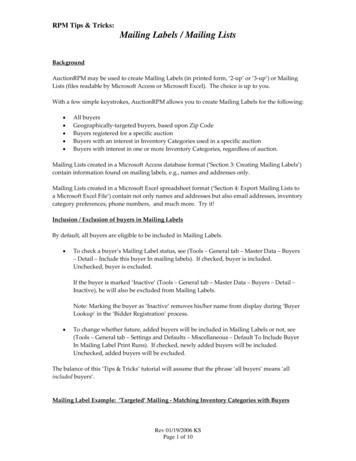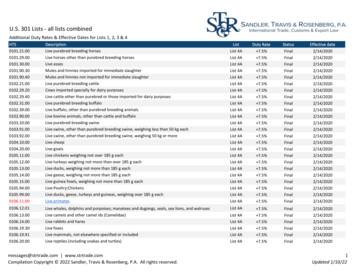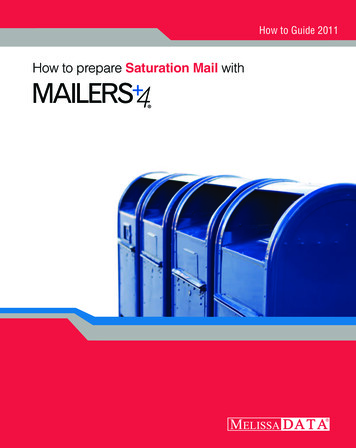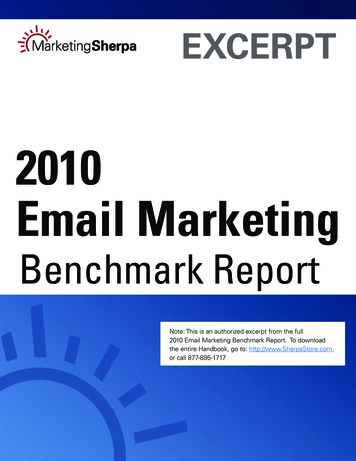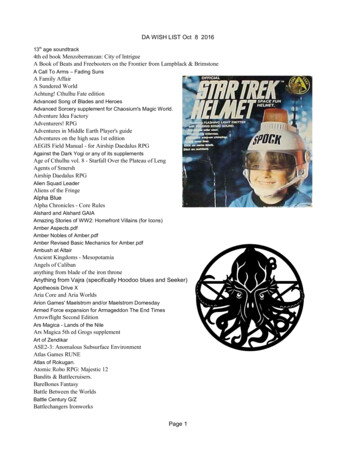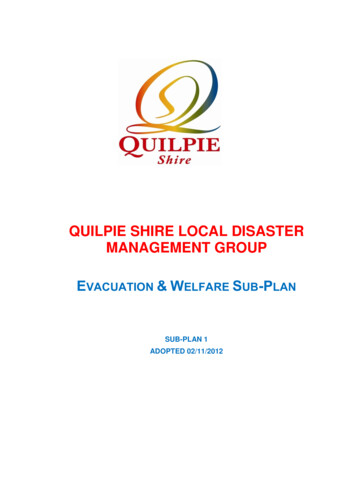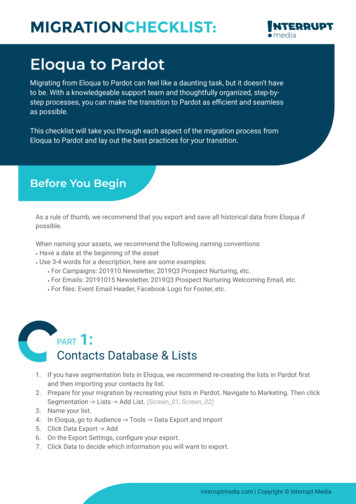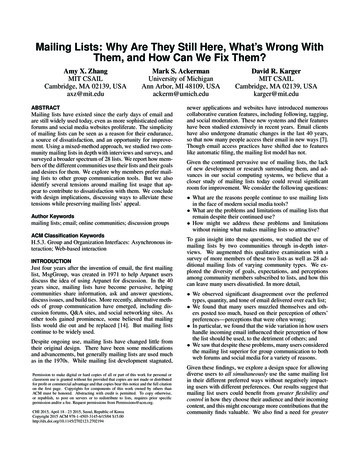
Transcription
Mailing Lists: Why Are They Still Here, What’s Wrong WithThem, and How Can We Fix Them?Amy X. ZhangMIT CSAILCambridge, MA 02139, USAaxz@mit.eduMark S. AckermanUniversity of MichiganAnn Arbor, MI 48109, USAackerm@umich.eduABSTRACTMailing lists have existed since the early days of email andare still widely used today, even as more sophisticated onlineforums and social media websites proliferate. The simplicityof mailing lists can be seen as a reason for their endurance,a source of dissatisfaction, and an opportunity for improvement. Using a mixed-method approach, we studied two community mailing lists in depth with interviews and surveys, andsurveyed a broader spectrum of 28 lists. We report how members of the different communities use their lists and their goalsand desires for them. We explore why members prefer mailing lists to other group communication tools. But we alsoidentify several tensions around mailing list usage that appear to contribute to dissatisfaction with them. We concludewith design implications, discussing ways to alleviate thesetensions while preserving mailing lists’ appeal.Author Keywordsmailing lists; email; online communities; discussion groupsACM Classification KeywordsH.5.3. Group and Organization Interfaces: Asynchronous interaction; Web-based interactionINTRODUCTIONJust four years after the invention of email, the first mailinglist, MsgGroup, was created in 1971 to help Arpanet usersdiscuss the idea of using Arpanet for discussion. In the 40years since, mailing lists have become pervasive, helpingcommunities share information, ask and answer questions,discuss issues, and build ties. More recently, alternative methods of group communication have emerged, including discussion forums, Q&A sites, and social networking sites. Asother tools gained prominence, some believed that mailinglists would die out and be replaced [14]. But mailing listscontinue to be widely used.Despite ongoing use, mailing lists have changed little fromtheir original design. There have been some modificationsand advancements, but generally mailing lists are used muchas in the 1970s. While mailing list development stagnated,Permission to make digital or hard copies of all or part of this work for personal orclassroom use is granted without fee provided that copies are not made or distributedfor profit or commercial advantage and that copies bear this notice and the full citationon the first page. Copyrights for components of this work owned by others thanACM must be honored. Abstracting with credit is permitted. To copy otherwise,or republish, to post on servers or to redistribute to lists, requires prior specificpermission and/or a fee. Request permissions from Permissions@acm.org.CHI 2015, April 18 - 23 2015, Seoul, Republic of KoreaCopyright 2015 ACM 978-1-4503-3145-6/15/04 d R. KargerMIT CSAILCambridge, MA 02139, USAkarger@mit.edunewer applications and websites have introduced numerouscollaborative curation features, including following, tagging,and social moderation. These new systems and their featureshave been studied extensively in recent years. Email clientshave also undergone dramatic changes in the last 40 years,so that now many people access their email in new ways [7].Though email access practices have shifted due to featureslike automatic filing, the mailing list model has not.Given the continued pervasive use of mailing lists, the lackof new development or research surrounding them, and advances in our social computing systems, we believe that acloser study of mailing lists today could reveal significantroom for improvement. We consider the following questions: What are the reasons people continue to use mailing listsin the face of modern social media tools? What are the problems and limitations of mailing lists thatremain despite their continued use? How might we address these problems and limitationswithout ruining what makes mailing lists so attractive?To gain insight into these questions, we studied the use ofmailing lists by two communities through in-depth interviews. We augmented this qualitative examination with asurvey of more members of these two lists as well as 28 additional mailing lists of varying community types. We explored the diversity of goals, expectations, and perceptionsamong community members subscribed to lists, and how thiscan leave many users dissatisfied. In more detail, We observed significant disagreement over the preferredtypes, quantity, and tone of email delivered over each list; We found that many users muzzled themselves and others posted too much, based on their perception of others’preferences—perceptions that were often wrong; In particular, we found that the wide variation in how usershandle incoming email influenced their perception of howthe list should be used, to the detriment of others; and We saw that despite these problems, many users consideredthe mailing list superior for group communication to bothweb forums and social media for a variety of reasons.Given these findings, we explore a design space for allowingdiverse users to all simultaneously use the same mailing listin their different preferred ways without negatively impacting users with different preferences. Our results suggest thatmailing list users could benefit from greater flexibility andcontrol in how they choose their audience and their incomingcontent, and this might encourage more contributions that thecommunity finds valuable. We also find a need for greater
transparency and social awareness within mailing list systems to allow users to better know who their audience is andhow their content is received.larger user population and a more diverse set of mailing lists,let us triangulate our interview findings.Interview StudyBACKGROUND AND RELATED WORKIn the 1990s to early 2000s, there was a great deal of excitement over the potential of mailing lists to connect geographically dispersed people in scholarly and professionalcircles [10]. Studies found that lists allowed highly affectiveinterpersonal interactions [17], encouraged reflection [10],and extended users’ social capital [16]. However, even thenthere were problems, such as complaints about flaming, lurkers, off-topic threads, and information overload [26]. Therewas also frustration with the need for time-consuming administrative moderation to maintain quality discourse [4]. Someissues with mailing lists in that period simply reflected general problems of email overload [5, 28]. Given the inflexibledesign of mailing lists, users had no recourse except to unsubscribe when they felt overloaded [26]. Problems were magnified when the messages were deemed nonessential or serveda different purpose than regular email, as was often the casefor mailing lists [22]. This suggests mailing lists may haveexacerbated email overload.Much has changed since these studies, suggesting we shouldre-examine mailing lists in light of today’s email clients andpractices. Popular clients such as Gmail now have featuressuch as threaded conversations and automatic filing and tagging, which may help with interruption fatigue and overload.However, this automatic handling may change the way usersaccess their mailing list email to something more like newsfeeds [23] such as on Facebook or Twitter, where users candip in occasionally to view content [2]. While much researchhas explored how email practices may affect the recipientsof email [8], we also consider the perceptions and attitudesof senders of email, including how their expectations of howothers receive their email can cause tensions.Research on motivations within group discussion systemssince the early 2000s have primarily focused on newer socialmedia. Studies have looked at what content users share andwhy [6, 11], and what they self-censor and why [24, 27, 15].Research has also looked into the motivations for participation specifically in online groups [21]. Research on FacebookGroups suggests that it is used for information sharing [25]as well as for socialization [20]. We extend this work byconsidering the ecology of options for group discussion today, specifically comparing users’ perceptions of mailing listswith those of more modern systems. Additionally, we bringattention back to the study of mailing list communities so asto encourage innovation in this area. We address a gap in theresearch literature by considering how mailing lists could beimproved given their simple design, and we reflect on howwe might incorporate some of the features in modern socialmedia without losing what makes mailing lists valuable.We began in May 2014 with in-person interviews of membersof two mailing list communities, summarized in Table 1 andcharacterized in more detail in the next section. The mailing lists were chosen because they were well established interms of age and integration into their respective communities, giving them a sizable membership, community participation ratio, and posting frequency that would allow for interesting dynamics to be observed. Our first mailing list, calledD ORM, is for members of a 300-person undergraduate dormitory of a mid-sized U.S. university. We interviewed 10(4 female, 6 male, median age of 22) members, including 8undergraduates and 2 residential advisors. Our second mailing list, called L AB, is for members, affiliates, and followersof a 1000-person technology research lab in a different midsized U.S. university. We interviewed 10 (1 female, 8 male,1 other, median age of 30) members, including 1 professor, 2administrators, 2 researchers, 4 graduate students, and 1 former graduate student. Potential interviewees were recruitedby emailing the target list, by emailing related mailing lists,and by word-of-mouth. We selected interviewees to reach adiverse set of users in terms of affiliation to the community,length of time in the community, and level of usage, includingthose who used the list infrequently or were unsubscribed.Interviews were conducted by the first author, lasted from 20to 80 minutes, and were mostly open-ended to allow users todescribe their experiences in detail. Before the interview, weasked interviewees to reflect on their experiences and bringtwo posts or threads that were memorable in either a good orbad way in order to ground our discussion. We began the interviews by asking users about the posts they brought as wellas their inclination or resistance to contributing in those instances. We then asked general open-ended questions aboutthe mailing list, such as their opinions and participation level.We also had interviewees bring their laptops and demonstratetheir strategies for organizing their mailing list email withintheir email client. Finally, we asked users to compare theirmailing list with other community discussion systems thatthey used and to imagine what the list would be like if migrated to such alternative systems.We employed a grounded theory approach [3] to elicit themesfrom the interviews. The interviews were coded by the firstauthor using standard qualitative coding techniques [18] tofind concepts around what users liked about mailing lists,frustrating or rewarding experiences, and moments of doubtor self-censorship. The authors as a group iteratively discussed the codes and grouped them into themes. Some groupings were generated from concepts that seemed contradictory;these form the tensions that we will describe later. Otherswere generated from commonly-expressed explanations forbehaviors and preferences.DATA COLLECTIONWe collected both interview and survey data. We used qualitative interview data to gain a deeper understanding of thetwo communities we studied. The surveys, which reached aSurveyUsing the themes generated, we then built a survey to seewhether our interview findings could be confirmed by a larger
D ORML ratedNoNoTable 1. The two mailing list populations studied in depth. *Number of subscribers in May 2014. **Posters refers to the number of unique contributorsfrom June 2013 to June 2014. ***Average number of posts per day, followed by standard deviation, from June 2013 to June 2014.subset of the two communities and by a more diverse set ofmailing list communities. Our 4 page SurveyMonkey websurvey combined multiple choice questions, free-responsequestions, and 5-point Likert scales. In addition to D ORMand L AB, we surveyed 28 other mailing list communities.These communities were found by asking others to publicizethe survey to mailing lists they used. We aimed to reach a diverse set of mailing list populations and selected communitiesof varying sizes and functions.Our survey investigated users’ attitudes towards and perceptions of their mailing list, which is why we relied on selfreported data. To build the survey, we took the themes fromour interpretive analysis and constructed sets of questions,with some multiple choice responses taken from the codesextracted from the interviews. We asked users about theirstrategies for managing their mailing list email and characteristics of the list. We inquired whether they cared about thingslike missed email, irrelevant content, or high volume. Wedelved into how users felt about lengthy discussions and whatgave them pause when considering posting. Finally, we askedusers to rate potential changes to the list, including introducing hypothetical features and moving to alternative systems.We screened out 74 people who completed the survey in under 4 minutes, completed less than half, or had a variancebelow 0.5 for answers to Likert scale questions, which haditems of reverse valence. Of 415 remaining participants, 43(37% male, 56% female, median age 21) were from D ORM,108 (67% male, 23% female, median age 27) were from L AB,and 264 (33% male, 65% female, median age 21) were fromother lists. Some chose not to divulge their gender or age.The demographics for D ORM and L AB respondents reasonably approximate those of the membership. We did note aslight skew in gender towards more female respondents; however, we were careful to consider this in our analysis and didnot find reason to suspect it would alter our main findings.The total number of subscribers and unique contributors inthe last year for D ORM and L AB are shown in Table 1. Wepresume that some email accounts were inactive or were filtered into a spam folder, but expect the number of people actually reading the mailing list to be somewhere between thesubscriber and unique contributor count. Thus, we believe thereal response rate to be above 5% for both communities.Our recruitment method of emailing the mailing list did notreach people who had left the list previously or did not checktheir email in time. This presents a non-response bias in oursurvey data, though we did take care to find and interviewpeople who had left the list or did not check it frequently.We were able to reach these people by inquiring in person tomembers of both communities. We discuss potential biasesin more detail below. Though we report numbers in the following sections to describe our survey results, these numbersFigure 1. Total number of emails per year for D ORM and L AB.should be regarded as indicative due to our low response rateand potential biases. For the Likert scale questions, we report1-2 as disagreeing with the statement, 3 as neutral, and 4-5 asagreeing.THE MAILING LIST COMMUNITIESWe begin with a deeper look at the communities that we interviewed and surveyed.The D ORM Mailing ListAs shown in Figure 1, the D ORM mailing list was started inthe fall of 2001 and increased in volume in the years since.The community of D ORM is composed of primarily undergraduates and some residential advisors and staff that live together in dormitory housing. Students are randomly assignedto the housing community during their first years and stay until they graduate, so they generally know each other by nameor face. Students are automatically added to the mailing listupon joining the community and removed when they leave,though they can unsubscribe at any time. As Table 1 shows,the number of unique posters over the year from June 2013 isquite close to the year’s subscription number, meaning almostall users posted to the list. However, about 25% of the uniqueposters only posted once. Interviewees described the contentas comprised mostly of publicity for events organized by students for other students, with event announcements appearingseveral times a day. This activity is so prevalent that studentsname it “pubbing.” This may explain why only about 30% ofthe year’s posts were replies. During our study, there werealso many posts by graduating seniors selling items, highlighting the periodic nature of content driven by the schoolyear cycle.The L AB Mailing ListThe L AB mailing list was started in 2004 and has since seen aconsiderable increase in volume, also shown in Figure 1. TheL AB community is composed mostly of current and alumnigraduate students and some faculty, research staff, administrators, and undergraduates that are members of a technologyresearch institute. Graduate students are automatically addedbut can unsubscribe at any time. The list is public, so affiliates of the lab or interested parties may also be on the list. Thevolume is generally less than D ORM and varies less. Interviewees described the list as a general-purpose list for the lab,
with many job postings, housing listings, event announcements, and occasionally interesting discussions. As seen inTable 1, there are over 4,000 subscribers although only 708unique people posted in a year’s time, suggesting that thereare many lurkers and dormant accounts on the list. Of thepeople who did post, 51% only posted once. At the other end,the most frequent poster on the list posted over three times asmuch as the next most frequent poster. This person was referenced many times by name in both interviews and surveysas a polarizing and outspoken list member.We additionally surveyed 28 other communities, with 3 sportsteams, 8 extracurricular or cultural clubs, 5 academic groups,6 dorms, 1 sorority, 3 social clubs, and 2 neighborhoods.Though we reached communities of different sizes and functions, many of them were connected to a university or werecomprised mostly of university students due to our method ofconvenience sampling. In a further section, we address thegeneralizability of our findings in light of our sample.WHY ARE MAILING LISTS STILL IMPORTANT?We first turn towards understanding why people still use mailing lists today in the face of modern communication systems.Following this section, we will address problems related tomailing lists before discussing potential fixes to these problems, keeping in mind the positives we explore here.We asked users to rate how often they used different groupcommunication systems, including mailing lists, FacebookGroups, Google Communities, subreddits, or discussion forums. We found that after mailing lists, the next most populartool for group communication was Facebook Groups. Whenasked about the Facebook Groups they were on, intervieweesoverall said that there was generally little activity and thatthey checked them much less frequently than their mailinglist emails, even if they checked Facebook several times aday. Some interviewees mentioned that D ORM and L AB infact had Facebook Groups, but that they had low membershipand were mostly dormant. When we refer back to Figure 1,we can see that volume on both mailing lists has gone up substantially over time even during the growth of Facebook.We asked users to imagine moving their mailing list to othersystems and consider what would change. Overall, interviewees believed that moving their list to Facebook would resultin less activity or discussion and preferred to continue usingtheir mailing list. From the surveys, only a small minorityof respondents liked the idea of moving their mailing list toa Facebook Group (13% agree, 15% neutral, 72% disagree).We found even lower percentages in favor of moving to a subreddit or a web forum (5% and 9% agree respectively). Wenow explore several differences we encountered in how people thought of email versus social media and how this playedinto their preference for mailing list communication.Email is for Work, Social Media for PlayFrom the surveys, a majority of users thought that email wasmore professional than Facebook (61% agree, 25% neutral,14% disagree). In a similar vein, interviewees associated discussion forums like Reddit with procrastination. When askedif the mailing list should move to Facebook, one user said:I wouldn’t be surprised if people start posting cat videosto this. [Facebook] has been a distraction for most people.When I look at [L AB].I don’t see it as a place to postcat videos. –L ABWhile interviewees overall felt that their mailing list contentwas more work-related than content on social media, manyinterviewees also agreed that some posts on the mailing listwere not work-related. One interviewee who enjoyed reading discussions on the mailing list felt that these discussionswould not thrive on Facebook, but they also did not quite fitwith his perception of email as more work-related:.it leaves the open discourse in an awkward split betweenpersonal conversation, Facebook Groups, and the part ofemail that’s not all business-y. –D ORMThe overloading of email with different types of content hasbeen described in prior work [8]. Overall few survey respondents minded that group discussions were going into theiremail (14% agree, 22% neutral, 64% disagree), though ourdata is biased in that users who unsubscribed were less likelyto respond to our survey. Some interviewees, one of whomhad unsubscribed, indicated that the discussions in their inbox distracted them from their work-related emails.Email Feels More Private than Social MediaWhen explaining low activity on Facebook Groups, a number of interviewees said that social media somehow felt morepublic than mailing lists. This was interesting because itwas technically untrue; both mailing list archives were public while a private Facebook Group would not be publiclyvisible. However, most interviewees of both groups were surprised to hear that the mailing list archives were public. Wealso found that both interviewees and those surveyed severelyunderestimated the number of people on their lists, echoingother research [1]. For instance, only 7% surveyed from L ABaccurately estimated how many people were subscribed. Instead, the median guessed list size was 500-800 people, anorder of magnitude less than the actual subscription count.Some interviewees reasoned that the archives were harder toaccess and read, while it would be easier to scroll down agroup’s Facebook page. Also addressing public exposure,many interviewees commented that on Facebook people’sidentities were more tied to their messages because of theproximity of profile images and linked profiles:There’s a greater sense of [Facebook] being public.youcan see everybody who’s on there. It’s very visible, verypresent. Whereas on email, you’re sending it into the mystic.you don’t see all the faces staring back at you. –D ORMGreater Confidence that Email will be SeenMany interviewees expressed the opinion that their mailinglist emails were more likely to be seen than a social mediapost. This may be partly due to email’s “push” model (seebelow) where emails are delivered to all recipients. In contrast, systems like Facebook that employ an opaque algorithmfor displaying content make a mystery of who receives what:Facebook plays games with what they show people and sothere’s no even clear notion of who it is that’s seen whatyou’re sending.[Email’s] really the only mechanism whereit comes with this feeling of it’ll get seen. –L AB
Despite the popularity of Facebook, many interviewees alsomentioned knowing people in the community who were noton Facebook but used email; reaching these people clearlyrequires using email. Several interviewees also stated thatthey checked their email more often than they checked Facebook, with a majority of those surveyed agreeing (67% agree,14% neutral, 19% disagree). Users might therefore sense thatemail delivery will be more timely than social media delivery.Like the privacy perception, this perception that mail will beseen and seen quickly can also prove false due to other recipients’ filtering choices, as we shall explore later.Email Management is More CustomizableAnother difference between email and social media is thatemail, using the SMTP standard, is more readily customizable and viewable with many different interfaces. Many interviewees preferred to have the flexibility to set up customfilters, tags, or notifications. One interviewee expressed frustration with Facebook’s interface, which is not customizable:You only have the choice [on Facebook Groups].I want towatch every message.or I don’t. If you say yes, then.yourcellphone [is] beeping every 5 minutes. If you say no,you’re going to miss everything. There’s no in betweenwhere once a day I can.see what’s new. –L ABIn the survey, a majority said that they enjoyed having theflexibility and power to organize their email the way theywanted (67% agree, 22% neutral, 11% disagree).TENSIONS WITHIN MAILING LIST COMMUNITIESWe now turn to examining several tensions that we observedwithin the mailing list communities we studied that may leadto problems. To facilitate our exploration, we categorize thetypes of mailing list posts into transactional (events, sales,etc.) and interactional (discussion, humor, etc.) communication. These categories have been used for spoken discourseand found in prior mailing list studies [9]. We acknowledgethat not all posts fit easily into one category and that someintended transactional posts become interactional.1Breaking down the mailing list content more finely, we askedsurvey respondents to self-report how often certain types ofposts occur and also how often they would like certain typesof posts to occur. In Figure 2, we plot the difference forD ORM and L AB. To validate our survey results, two people were employed to manually tag 100 random emails fromMay 2014 from each mailing list into one of 9 categories wechose, given the subject line and body of the email (Cohen’skappa 0.698). After resolving disagreements through discussion, we found that with minor exceptions people’s perceptions of how many emails they received of each categorygenerally aligned with the normalized frequencies we found.For instance, our tagging over-reported the category of “interesting discussions” compared to survey respondents’ perceptions. This may be because we could only safely tag all emailsthat were discussion-related, without knowing the context forwhether it was interesting or annoying.1For instance, our post to L AB soliciting participants for our surveyturned into a multi-week, 70-post discussion on the ethics of usingAmazon gift cards as a reward.Figure 2. Survey results drawing an arrow starting from the numberof times users stated a type of post occurred (circle) and ending at howoften users would have liked for it to appear (arrow). Ratings are displayed as averages. Scale is 1–Never, 2–Once a month, 3–Once a week,4–Once a day, 5–More than once a day.D ORMOne of my favorite.types, is the sort of intellectual discourse.therewas a golden time, where you had the right combination of people, youcould get a good.intellectual discussion.- I personally am glad that [the discussion is] gone. I think it keeps[D ORM] to be much more efficient.L AB I sometimes wish there were more meaningful conversations about technology and less about logistics and so on. .Those things show up a lotin talks but I don’t think people discuss them enough.- .if I had to pinpoint an ideal level for me, personally, I don’t know,maybe 10 to 15 percent less of what [the discussion level] currently isright now, would be great.Table 2. Interview quotes expressing positive and negative feelings aboutinteractional content on the two mailing lists. Tension 1: Type and Quantity of ContentOur interviews revealed that often users, even within the samecommunity, had different ideas about what their mailing listsshould contain. For instance, we learned from the senior student interviewees of D ORM that the mailing list used to havemore discussions during their sophomore year, because of acertain set of outspoken seniors. Table 2 shows that interviewees disagreed on whether that was a good thing. Interviewees in L AB also disagreed on the optimum level of interactional content. When it came to more specific categoriesof email, such as the ones in Figure 2, interviewees also disagreed. Some interviewees were strongly in favor of morelighthearted humor or silliness on the mailing list while otherswere strictly against it. As another example, one intervieweespoke about job postings:I think people will differ in that evaluation. I’m sure there’slots of people who actually appreciate the job postings andstuff whereas I’m not looking for a job. –L ABSome users acknowledged the tension between the two functions of the list:The users of [D ORM] are the types of people that don’treally care about spammy stuff in their inbox .Only uponreflection of what [D ORM] used to be, do I stop and thinklike yeah, maybe that spammy stuff kind of pushed out moreof that intellectual conversation. –D ORM
I think it is kind of a Catch 22.I want more discussion butI also don’t want to put myself out there. –D ORMFigure 3. The discussion-desired measure, from 2–least desired to 10–most desired, for D ORM and L AB.When asked if the mailing list should stick to informationalposts, a sizable minority of survey respondents agreed (24%).On the flip side, 34% wished the list had more discussions.Because th
for mailing lists [22]. This suggests mailing lists may have exacerbated email overload. Much has changed since these studies, suggesting we should re-examine mailing lists in light of today's email clients and practices. Popular clients such as Gmail now have features such as threaded conversations and automatic filing and tag-
